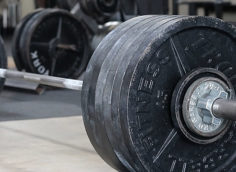Squats are vital for building tree-trunk legs. But if you want to develop the most impressive quads possible, you'd better start rethinking your definition of squats.
The classic versions (back and front squats) fail to effectively hit all the muscles that make up the quadriceps. That's where a different kind of squat comes in.
Our quads are made up of four different muscles. Three of these – the vastus lateralis, medialis, and intermedius – cross only the knee joint and get worked really well with most squats. In contrast, the fourth muscle, the rectus femoris, crosses both the hip and the knee.
When we do normal squats, we bend both our knees and hips. This makes it more challenging for the rectus femoris to generate tension and contribute substantially in force production. That means it doesn't get much growth from just squatting. But when we do lifts where our hip doesn't move, such as leg extensions, we can properly train our rectus femoris and our quads as a whole.
However, there's still room for improvement since the rectus femoris has a second important action, hip flexion, which doesn't get maximally challenged with leg extensions.
If you want to maximally stimulate growth in a muscle, you'll challenge it with all of its functions to hit all of the varying muscle fibers. Additionally, you'll see more hypertrophy when you work muscles at longer muscle lengths.
That's where the sissy squat shines since it can force the rectus femoris to both do hip flexion (isometrically) and knee extension, while getting into some higher degrees of length.
Now while this squat variation is awesome, it alone isn't that challenging for more advanced lifters. It's kind of like push-ups, and that's where more advanced progressions come in. With these we can take a basic bodyweight movement and turn it into an intense quad builder.
Hold one dumbbell down to your side. If you don't have dumbbells, use any kind of extra load, such as a backpack or water jug. It's best to start light and get comfortable with the movement before adding significant load. (I've worked up to a 24kg kettlebell and it lit me up.)
Don't forget to switch sides with your load since holding it on one side does preference one leg over the other. Whichever leg is on the side holding the weight will get worked slightly harder since you're resisting rotating that direction.
You can either split up your sets, doing half of your reps with weight on one side and then the other, or do one set with it in one hand and one set with it in the other hand. Either way, just try to distribute it evenly.
Hold a dumbbell or kettlebell to your chest. Setting it up this way is actually harder because the weight ends up being further away from your axis point, making the moment arm longer.
Again, one leg is worked more than the other, so factor that in. If you hold the weight closer to your midline, this is less of an issue compared to the last variation, so try to just bring the weight closer in line with your chest and you might find you work your legs evenly. Either way, it's beneficial to rotate which side you hold the weight.
This option will light up your core! Set up with the barbell anchored down low and then have the bar at your chest in a goblet grip.
What's cool about this variation is that if you stand further back, the landmine essentially just acts more like a core-challenging hand support than resistance. But as you move your feet closer and your knees go forward and your torso goes further back, you'll get challenged more by the resistance.
If you're struggling with it, you can play around with letting your hips bend too and making it more of a heel-elevated goblet squat.
Set up with the end of the bar on one shoulder. It can be helpful to have a plate on the bar for your shoulder push against for more support. You'll need to play around with your foot distance, but once you find it you can get a nice arc motion.
The landmine arcing motion works really well here because as you bend your knees and they go down and forward, the bar will follow a similar line. With the last version, it really challenges the core, whereas this one puts more emphasis on the quads.
You can also play around with the amount of hip bend if you're struggling with getting the motion down.
The first four options required either a dumbbell or a barbell, which you may not have. With this option you go with a large band. Loop the band in front of your shoulders and behind your neck.
The band is a really good loading option for people who aren't very comfortable going deep with load yet. It'll pull more load at the top and less as you go lower. Since the band is in front of your shoulders and behind your neck, you shouldn't have a problem. Just don't run it in front of your neck since that's obviously a choking hazard. Get started and just let the band move in front of your shoulders.





